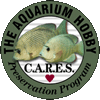Ameca splendens
Miller & Fitzsimons, 1971
Butterfly Goodeid



Above: A male Butterfly Goodeid. Photo by Sam Borstein.
Etymology:
Genus- Ameca= named after the river it is from, The Rio Ameca.
Species- splendens= shinning (Latin).
Intro:
Ameca splendens is a nice little livebearer from Mexico and one that is on the verge of extinction. Only one population of this fish remains in the wild and it is in the middle of an amusement park in Mexico. Because of this, the Butterfly Goodeid is commonly bred in species maintenence programs. This pretty goodeid is a peaceful and welcome aquarium resident that offers to add a little brightness as well. Although females are generally an olive and black mottled fish, males develop very yellow fins, giving them the common name the Butterfly Goodeid.
Distribution:
The Butterfly Goodeid is native to the Rio Ameca and its’ tributaries in Mexico.
Size, Maturity, and Sexual Dimorphism:
Size: Males- 4 inches, Females- 3 inches
Maturity: 2.5 inches
Sexual Dimorphism: Males are smaller than females and have a yellow edge to the caudal fin. Males also possess and andropodium, which is a modified anal fin for reproduction. This is seen as a notch in the male’s anal fin.

Above: A female Butterfly Goodeid. Photo by Sam Borstein.
Care:
Butterfly Goodeids are easy to care for. Although some people would say they are aggressive, I'd disagree. They can be nippy and chase each other. I think it is best to keep this species in a large group of 8+ individuals. They can be mixed with other fish and mix well with Central American cichlids.
Diet:
Butterfly Goodeids are omnivorous and will eat anything in aquarium. They predominantly feed on vegetable matter in the wild and a spirulina flake would be beneficial to its diet.
Breeding:
Butterfly Goodeids breed like most goodeids. This species has a very long gestation period of nearly two months! It's important to note that goodeids don't store sperm like other livebearers and need to spawn for each brood.
The fry are huge when born, about .75 inches long! Spawns can range from 5-25 per brood. Larger females have larger spawns. The fry hang at the top of the tank for their first week out of the womb. The fry are very easy to raise and will feed right away on crushed flake. I prefer to use baby brine shrimp to raise them. The fry grow quickly and look just like females in terms of coloration.
Conclusion:
Ameca splendens was once a very popular fish in the aquarium trade. Recently, that has changed. It is still available from hobbyists and is inexpensive. Why it isn't more popular is a mystery as it is a very attractive fish that is not demanding.
References:
- IUCN. IUCN Red List of Threatened Species. <http://www.iucnredlist.org>.
- Miller, R.R., Fitzsimons, J.M., (1971) Ameca splendens, a new genus and species of goodeid fish from western Mexico, with remarks on the classification of the Goodeidae. Copeia 1, 1–13.
- Miller, R.R., Minckley, W.L. & Norris, S.M. (2005) Freshwater Fishes of México. Museum of Zoology, University of Michigan, & University of Chicago Press, Chicago, 652 pp.
